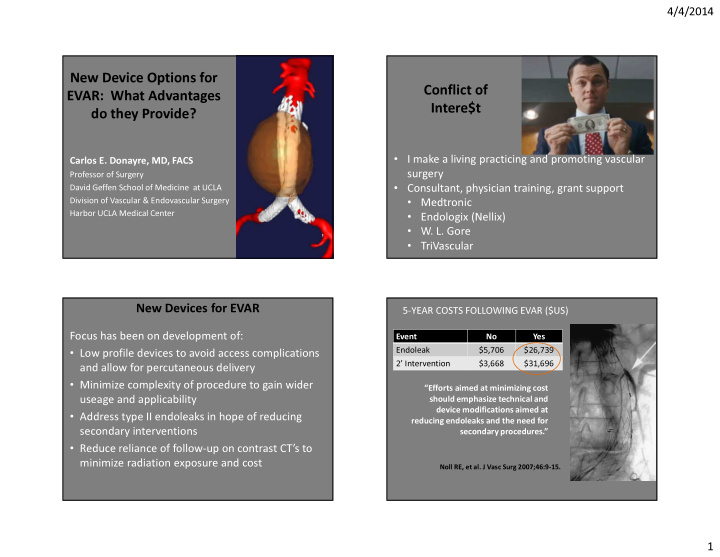



4/4/2014 New Device Options for Conflict of EVAR: What Advantages Intere$t do they Provide? • I make a living practicing and promoting vascular Carlos E. Donayre, MD, FACS surgery Professor of Surgery • Consultant, physician training, grant support David Geffen School of Medicine at UCLA • Medtronic Division of Vascular & Endovascular Surgery • Endologix (Nellix) Harbor UCLA Medical Center • W. L. Gore • TriVascular New Devices for EVAR 5-YEAR COSTS FOLLOWING EVAR ($US) Focus has been on development of: Event No Yes • Low profile devices to avoid access complications Endoleak $5,706 $26,739 2’ Intervention $3,668 $31,696 and allow for percutaneous delivery • Minimize complexity of procedure to gain wider “Efforts aimed at minimizing cost useage and applicability should emphasize technical and device modifications aimed at • Address type II endoleaks in hope of reducing reducing endoleaks and the need for secondary interventions secondary procedures.” • Reduce reliance of follow-up on contrast CT’s to minimize radiation exposure and cost Noll RE, et al. J Vasc Surg 2007;46:9-15. 1
4/4/2014 Altura Endograft Partial Suprarenal Independent Suprarenal Deployment Renal Positioning Deployment System Modular prosthesis with a flexible nitinol skeleton covered by a ribbed low porosity polyester fabric • No need for contralateral gate canulation • Suprarenal fixation and adjustable in situ iliac extensions • Delivery through any 14 Fr sheath • Semi-circular “kissing” aortic bodies 1st in Man – Santiago, Chile (May 5, 2011) Aortic Body Bilateral Iliac Limb Altura Deployment Deployment Endosystem 2
4/4/2014 CT Reconstructions at 1 Year CT at 1 Year – Significant Sac Shrinkage 23 patients enrolled Aneurysm sac shrinkage during follow-up • 91 % male • Age 75.5 ± 7.4 years • AAA diameter - avg 52.1 mm ( 46 – 68 ) 52.9 52.3 CTA follow up at 6 m (12 patients) • All the devices remain patent • Type I endoleak: 0 48.0 • Type II endoleak: 3 • No device migration or type III 45.2 CTA follow up at 1 year (8 patients) • All the devices remain patent • Type I endoleak: 1 • Type II endoleak: 1 • No device migration or type III Pre-Op 1 Mo (13) 6 Mos (9) 1 Yr (5) 3
4/4/2014 Cardiatis Multilayer Aneurysm Repair System Cardiatis Multilayer Aneurysm Repair System (MARS) Multi-layered stent induces “flow modulation” leading to thrombosis of the sac & laminar flow to side branches arising from the aneurysmal sac CE marked • Peripheral and visceral aneurysms • Used in thoracic and abdominal A. Blood flow through a saccular aortic aneurysm B. Saccular aortic aneurysm with an increased flow velocity aortic aneurysms • C . Saccular aortic aneurysm treated with a multilayer stent, which Not to be used in rAAA decreases the flow velocity into the aneurysm D. Blood flow though the multilayer stent maintains flow to collaterals as the aortic aneurysm thromboses 4
4/4/2014 TAA Type II (4.7 cm) Cardiatis -- Orebro Study Covered with 2 overlapping 13 compassionate cases treated: Multilayer stents 11 Thoracoabdominal aneurysms 2 Abdominal aortic aneurysms 4 of the above were symptomatic 5 mortalities: 3 Non-aneurysmal related 2 cardiac / 1 unknown cause 2 Ruptures related to aneurysm No decrease in aneurysm size at 15 months of follow- up, and 2 patients with significant increase in size NELLIX DESIGN GOALS Nellix -- The Sac Anchoring Prostheses Cobalt Simplify EVAR procedure Chromium Endoframe • Simple & intuitive Steps • Small inventory to treat all infrarenal AAA patients PEG Filled Clinical Outcome Goals Endobag • Eliminate secondary interventions • Reduce required patient surveillance ePTFE Endobag 5
4/4/2014 NELLIX STENT DESIGN NELLIX ENDOBAG DESIGN • Cobalt chromium alloy • Balloon-expandable • Durable polyurethane • Create flow lumens to iliacs • High strength PTFE • Highly flexible sleeve • Crush resistant • Oversized to flow lumen • 1200 – 1400 mmHg • Aortic Bags: 6.0cm • Highly flexible diameter • Seal aneurysm sac ADVANCE CATHETERS OVER 0.035” GUIDEWIRES BIOSTABLE POLYMER • Advance both Catheters over guidewires • Polyethylene Glycol (PEG) • Position Catheters under fluoroscopy Diacrylate • Pull back Catheter sheaths • Reposition Catheters under fluoroscopy • Viscosity of water • Fills EndoBags to seal the sac • Cures in 3 to 5 minutes • Consistency of a soft pencil eraser 6
4/4/2014 NELLIX CONSOLE Step 4: Shoot contrast through Angio-Tip to verify Seal Allow Polymer to cure (3-5 minutes ) Adverse Aortic Neck Anatomy NELLIX PRE & POST IMPLANT Flow Model: Posterior view of aortic neck 7
4/4/2014 CASE OVERVIEW: 6.0CM AAA WITH 10MM LENGTH NECK AND 3.5CM RCIAA Pre-Operative Post-Operative: Right Hypogastric Post Operative: 1 Year Artery Preserved with a Nellix Extender AAA 6.3 cm 30 days Type I Endoleak Sac with limited rim enhancement and no outflow 1 year 60 days 8
4/4/2014 The Nellix sac sealing system appears ideally EVAR for rAAA’s suited to treat rAAA’s � EVAR for r-AAA’s is gaining widespread use and acceptance as the best way to treat rAAA’s � Devices introduced via bilateral femoral access � In the past general surgeons performed most of open repairs � Balloons inflated with contrast for rAAA’s • Controls bleeding & allows for fluid resuscitation � Today that is no longer the case • Outline of aneurysm sac is obtained � Vascular fellows more are more confortable performing • Angiogram performed from leading Nellix catheters to EVAR than doing an open AAA repair identify the renal arteries � At a recent SVS meeting, vascular fellows felt their � Devices are repositioned and endoframes are greatest challenge was doing open aortic procedures expanded � Balloon control has been found to be beneficial in open and � Contrast in balloons is then exchanged for polymer endovascular treatment of rAAA ‘s Nellix Single System: Rupture (4 year explant) Contrast � PEG Filled Endobags Balloon Expanded Aortogram Endoframes 9
4/4/2014 Excess polymer injected at implantation 10
Recommend
More recommend